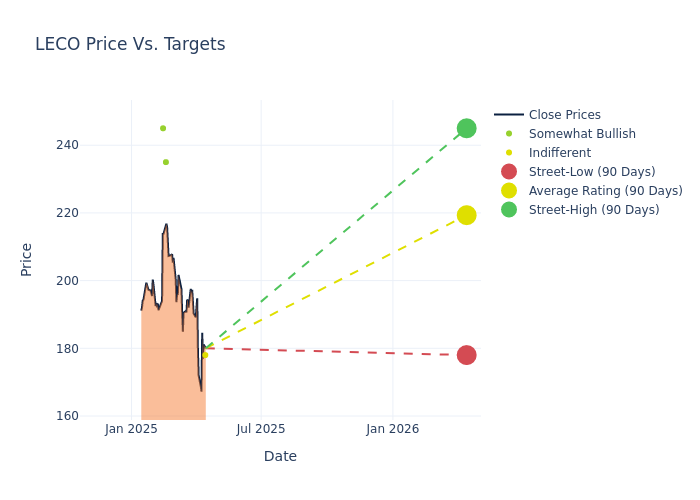
Analysts' ratings for Lincoln Electric Holdings (NASDAQ:LECO) over the last quarter vary from bullish to bearish, as provided by 4 analysts.
The table below provides a snapshot of their recent ratings, showcasing how sentiments have evolved over the past 30 days and comparing them to the preceding months.
| Bullish | Somewhat Bullish | Indifferent | Somewhat Bearish | Bearish | |
|---|---|---|---|---|---|
| Total Ratings | 0 | 2 | 2 | 0 | 0 |
| Last 30D | 0 | 0 | 1 | 0 | 0 |
| 1M Ago | 0 | 0 | 0 | 0 | 0 |
| 2M Ago | 0 | 2 | 0 | 0 | 0 |
| 3M Ago | 0 | 0 | 1 | 0 | 0 |
Providing deeper insights, analysts have established 12-month price targets, indicating an average target of $217.25, along with a high estimate of $245.00 and a low estimate of $178.00. A 1.92% drop is evident in the current average compared to the previous average price target of $221.50.

Breaking Down Analyst Ratings: A Detailed Examination
An in-depth analysis of recent analyst actions unveils how financial experts perceive Lincoln Electric Holdings. The following summary outlines key analysts, their recent evaluations, and adjustments to ratings and price targets.
| Analyst | Analyst Firm | Action Taken | Rating |Current Price Target| Prior Price Target | |--------------------|--------------------|---------------|---------------|--------------------|--------------------| |Nathan Jones |Stifel |Lowers |Hold | $178.00|$220.00 | |Adam Seiden |Barclays |Raises |Overweight | $235.00|$220.00 | |Jason Celino |Keybanc |Raises |Overweight | $245.00|$230.00 | |Nathan Jones |Stifel |Lowers |Hold | $211.00|$216.00 |
Key Insights:
- Action Taken: Analysts adapt their recommendations to changing market conditions and company performance. Whether they 'Maintain', 'Raise' or 'Lower' their stance, it reflects their response to recent developments related to Lincoln Electric Holdings. This information provides a snapshot of how analysts perceive the current state of the company.
- Rating: Delving into assessments, analysts assign qualitative values, from 'Outperform' to 'Underperform'. These ratings communicate expectations for the relative performance of Lincoln Electric Holdings compared to the broader market.
- Price Targets: Understanding forecasts, analysts offer estimates for Lincoln Electric Holdings's future value. Examining the current and prior targets provides insight into analysts' changing expectations.
Assessing these analyst evaluations alongside crucial financial indicators can provide a comprehensive overview of Lincoln Electric Holdings's market position. Stay informed and make well-judged decisions with the assistance of our Ratings Table.
Stay up to date on Lincoln Electric Holdings analyst ratings.
Unveiling the Story Behind Lincoln Electric Holdings
Lincoln Electric is a leading manufacturer of welding, cutting, and brazing products. The firm's portfolio of products includes arc-welding solutions, plasma and oxy-fuel cutting systems, and brazing and soldering alloys, as well as automation solutions. Lincoln Electric serves clients in the general fabrication, heavy industries, automotive, construction, shipbuilding, energy and process industries, among other end markets. Based in Cleveland, Ohio, Lincoln Electric has operations in 19 countries and has 11,000 employees worldwide. The company generated roughly $4 billion in sales in 2024.
Key Indicators: Lincoln Electric Holdings's Financial Health
Market Capitalization Analysis: Reflecting a smaller scale, the company's market capitalization is positioned below industry averages. This could be attributed to factors such as growth expectations or operational capacity.
Negative Revenue Trend: Examining Lincoln Electric Holdings's financials over 3M reveals challenges. As of 31 December, 2024, the company experienced a decline of approximately -3.45% in revenue growth, reflecting a decrease in top-line earnings. When compared to others in the Industrials sector, the company faces challenges, achieving a growth rate lower than the average among peers.
Net Margin: Lincoln Electric Holdings's net margin is below industry averages, indicating potential challenges in maintaining strong profitability. With a net margin of 13.72%, the company may face hurdles in effective cost management.
Return on Equity (ROE): Lincoln Electric Holdings's ROE surpasses industry standards, highlighting the company's exceptional financial performance. With an impressive 10.52% ROE, the company effectively utilizes shareholder equity capital.
Return on Assets (ROA): Lincoln Electric Holdings's ROA surpasses industry standards, highlighting the company's exceptional financial performance. With an impressive 3.9% ROA, the company effectively utilizes its assets for optimal returns.
Debt Management: With a high debt-to-equity ratio of 0.95, Lincoln Electric Holdings faces challenges in effectively managing its debt levels, indicating potential financial strain.
Understanding the Relevance of Analyst Ratings
Experts in banking and financial systems, analysts specialize in reporting for specific stocks or defined sectors. Their comprehensive research involves attending company conference calls and meetings, analyzing financial statements, and engaging with insiders to generate what are known as analyst ratings for stocks. Typically, analysts assess and rate each stock once per quarter.
Analysts may supplement their ratings with predictions for metrics like growth estimates, earnings, and revenue, offering investors a more comprehensive outlook. However, investors should be mindful that analysts, like any human, can have subjective perspectives influencing their forecasts.
Which Stocks Are Analysts Recommending Now?
Benzinga Edge gives you instant access to all major analyst upgrades, downgrades, and price targets. Sort by accuracy, upside potential, and more. Click here to stay ahead of the market.
This article was generated by Benzinga's automated content engine and reviewed by an editor.